Scale Bureau 1/48 Yak-9U (P)
Aleks Šekularac
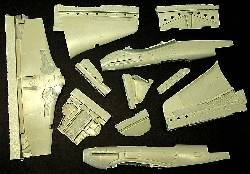
Scale Bureau 1/48 Yak-9U (P)Aleks Šekularac |
 |
Zenith of Yakovlev’s “9” family of aircraft – the most numerous and influential lineage in the VVS from 1943 to the end of the war – was achieved with Yak-9U and its all-metal progeny, the Yak-9P. These were the last production fighters with internal combustion engines to come out of the OKB Yakovlev.
The marriage of the aerodynamically improved “9” airframe with the mighty but temperamental Klimov VK-107A 4-valve supercharged V-12 secured unrivaled performance, yet brought along number of complications as well. New powerhouse had notoriety for overheating and loss of oil-pressure, with very poor operational life expectancy. Continuous improvements to the engine and the cooling system, particularly replacing the radiators with more efficient units (OP-728 and OP-726), alleviated some of the issues (by the beginning of 1945), but the engine remained the “mechanic’s-nightmare” throughout the production.
Yak-9U was christened in combat in October 1944, establishing supremacy under all conditions over its common Luftwaffe opponents: Bf-109Gs and FW-190s. 32 machines were delivered for the first time to the 163 IAP for combat trials. In the short period that followed 28 enemy fighters were destroyed in aerial combat for the loss of two Yaks. Broader introduction to service was equally impressive. With the implemented production improvements Yak-9U became more reliable and its performance further enhanced.
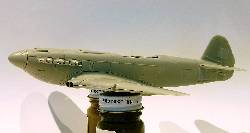 In
the closing months of the war came the proposal for the heavily armed fighter,
the Yak-9UT. Great array of weaponry was tried, firing through the propeller
shaft: the ShVAK, B-20, Vya-23, NS-37, and even the super-heavy 57mm anti-armor
cannon (ultimately rejected). This version however did not see great numbers,
with less than 300 produced.
In
the closing months of the war came the proposal for the heavily armed fighter,
the Yak-9UT. Great array of weaponry was tried, firing through the propeller
shaft: the ShVAK, B-20, Vya-23, NS-37, and even the super-heavy 57mm anti-armor
cannon (ultimately rejected). This version however did not see great numbers,
with less than 300 produced.
The post-war, all-metal Yak-9P became a common sight on airports in occupied Germany. “P” also went to serve with many allies of the SSSR after the war, subjected to numerous modifications. It was also thrown in combat in Korea, but soon becoming an underdog to the galloping jet propulsion.
The old saying: “what looks well - flies well”, holds true here, and it is only proper that these ultimate Yaks are also the sleekest of them all.
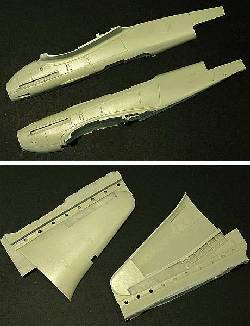
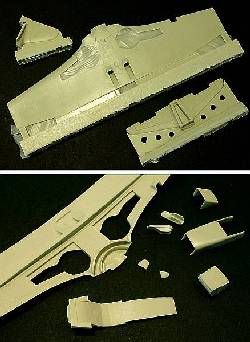 To
my knowledge there were no kits of this aircraft type in 1/48 scale until now.
So, Scale Bureau from Moscow gets a big bonus right from the start, by tackling
this significant and attractive subject, ignored by the mainstream producers.
Sometimes this would be enough to recommend the kit as the “only game
in town”, but Scale Bureau luckily does not play on the novelty card alone.
Not by a long way…
To
my knowledge there were no kits of this aircraft type in 1/48 scale until now.
So, Scale Bureau from Moscow gets a big bonus right from the start, by tackling
this significant and attractive subject, ignored by the mainstream producers.
Sometimes this would be enough to recommend the kit as the “only game
in town”, but Scale Bureau luckily does not play on the novelty card alone.
Not by a long way…
This is an all-resin kit – the qualification sufficient to turn away 80% of otherwise enthusiastic modeler a decade ago. But not today! The comparison of this kit with recent state-of-the-art products from Vector, mainly the 1/48 Lavockin family, is almost inevitable. Indeed, the two are very similar in approach and achievement. Similar, but not the same…
The kit is skillfully cast in mellow-olive resin. Parts are very light, so the finished kit will weigh no more than its injection-cast styrene equivalent would. Truly commendable, this! The surface finish is very good, with almost no imperfections at all, and only selected places needing light sanding to bring them to smoothness. Details are excellent throughout
All main flying surfaces have line-contact casting gates, much like the early Vector kits. Curiously, fuselage halves are free of any casting blocks/gates, and only some thin resin film needs to be cleaned before the assembly.
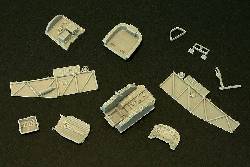 There
is an abundance of well cast details in the cockpit. Instrument panel is made
solid, with instrument backs and blank fronts, while instrument faces are supplied
all as individual decals. A novel approach in this scale, but the poor resolution
of instrument decals renders them little more than black dots (see image at
the bottom). I’d personally prefer the perforated resin panel and acetate
insert with printed instrument faces.
There
is an abundance of well cast details in the cockpit. Instrument panel is made
solid, with instrument backs and blank fronts, while instrument faces are supplied
all as individual decals. A novel approach in this scale, but the poor resolution
of instrument decals renders them little more than black dots (see image at
the bottom). I’d personally prefer the perforated resin panel and acetate
insert with printed instrument faces.
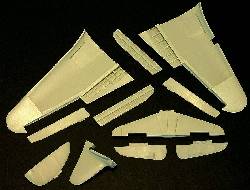 Some
work is needed with the tubular side structure elements in the cockpit. These
are cast on a wall of resin, and instructions call for this wall to be removed
in-between the tubes, using a scalpel. Instead of the brute force approach that
can result in some damage to the resin and/or fingers, I’d advise to simply
sand the underside of this block of resin (against a flat surface) until the
resin wall becomes see-through thin, at which point it can be removed even with
a toothpick.
Some
work is needed with the tubular side structure elements in the cockpit. These
are cast on a wall of resin, and instructions call for this wall to be removed
in-between the tubes, using a scalpel. Instead of the brute force approach that
can result in some damage to the resin and/or fingers, I’d advise to simply
sand the underside of this block of resin (against a flat surface) until the
resin wall becomes see-through thin, at which point it can be removed even with
a toothpick.
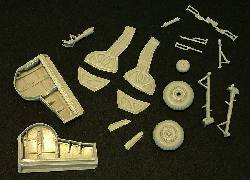 Excellent
work in the cockpit is reflected on all major outer parts as well. The control
surfaces are all separate (flap inner structure is sublime), trailing edges
straight and sharp, panel lines well defined, exhaust stubs superbly sculpted
and hollow, tricky wing-root intakes very clever and elegant (superior solution
to Vector’s LaGGs here), landing gear elements precise and proper…
in short, it will be a pleasure to build this kit.
Excellent
work in the cockpit is reflected on all major outer parts as well. The control
surfaces are all separate (flap inner structure is sublime), trailing edges
straight and sharp, panel lines well defined, exhaust stubs superbly sculpted
and hollow, tricky wing-root intakes very clever and elegant (superior solution
to Vector’s LaGGs here), landing gear elements precise and proper…
in short, it will be a pleasure to build this kit.
But, what type is this model exactly representing? To answer this question I had to do a bit of research and school myself on nuances of Yakovlev’s late-war design evolution. As usual with all things VVS, one finds all sorts of vague, ambiguous and contradictory claims, but after a while it is possible to distil some sense out of it.
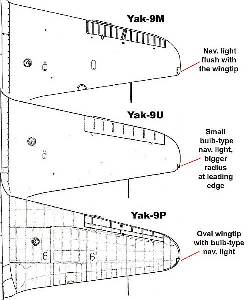 The
biggest point of contention was the shape of wingtips. Beginning with Yak-9M
and ending with Yak-9P there were three distinct wingtip shapes (see attached
image) and the kit definitely represents the final one. The standard Yak-9U
wingtip (the middle of the three) is very hard do discern on photographs and
can be easily confused with the rounder -9P wingtip, particularly from a shallow
angle (due to the similar arrangement of the nav-light bulbs). Never the less,
the two were different!
The
biggest point of contention was the shape of wingtips. Beginning with Yak-9M
and ending with Yak-9P there were three distinct wingtip shapes (see attached
image) and the kit definitely represents the final one. The standard Yak-9U
wingtip (the middle of the three) is very hard do discern on photographs and
can be easily confused with the rounder -9P wingtip, particularly from a shallow
angle (due to the similar arrangement of the nav-light bulbs). Never the less,
the two were different!
Scale Bureau kit therefore offers the Yak-9P wing, but without visible panel lines associated with the all-metal Yak-9P construction. Stern fuselage halves are also smooth, as on the wooden Yak-9U.
So here’s my finding:
OK then, with this topic absorbed, all other kit elements look accurate against available references. Without a doubt this is the most authentic representative of Yak’s “9” pedigree in 1/48 scale (ICM kits have many geometric problems in comparison).
As previously mentioned, the decals are provided for Yak-9U and -9P types, on two extensive sheets made by Begeomot (one for each). The camouflage instructions are given only for the Yak-9U however. To anybody interested in available -9P variants, I’d recommend getting Mushroom Model Publications “Yak-9U & P” book, where large scale color profiles exist for all the aircraft from these two sheets.
The available choice is as follows:
What more could you want?
This is a first-rate kit that will build with ease in a very unique and most handsome model. Actually, the only issue baring it from across-the-board excellence is previously mentioned wing-tip affair.
This is also a mightily impressive premier for Scale Bureau. Makes me look in anticipation for further releases from this company…
To my knowledge Scale Bureau does not have international distributors yet, so I cannot comment on the price and availability of this kit. I am however convinced that it won’t take long for the hobby-stores worldwide to add this kit to the inventory. It definitely deserves it!
1. Yak-9, Liepnik D. L.
2. Jak Fighters 1941-1945, A. V. Stankov
3. Yak-9U & P, Robert Panek, Mushroom Model Publications
4. Dragons On Bird Wings, V. Antipov / I. Utkin, Aviaeology
5. Yak-7/9, Robert Bock, AJ-Press
6. Soviet Air Force Fighter Colors: 1941-45, E. Plawskii, Classic Colors
7. Yak-9U line drawings, „Aviatsia i Vremia“, 2005.
8. Yak-9U line drawings by A. A. Jurgenson
9. Yak-9P line drawings by Z. Luranc.